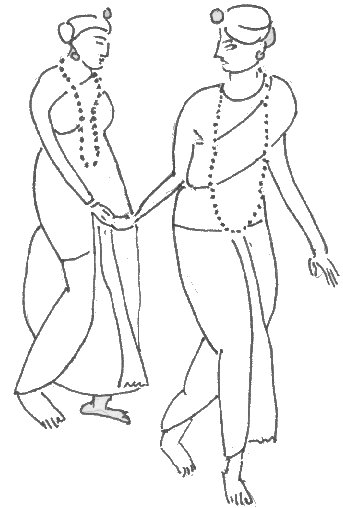The Sacrament of Marriage
by Dr. Jyotsna Kamat
First Online: January 02, 2008
Page Last Updated: December 07, 2024
Among the Hindus, the marriage was the most important ritual among all samskars. Smriti writers including Manu extol the importance and responsibility of a householder. Marriage was a prerequisite of a household. "Just as all creatures exist by virtue of air, so do all the Ashrams, Brahmacharya (celibacy), Grihastha (house holder), Vanaprastha (recluse), Sannyasa (renunciation) depend upon the householder" declared Manu.
K.L. Kamat/Kamat's Potpourri
Groom Walks with Bride in Marriage
In ancient India it was an accepted norm that a householder should support youngsters, fellow beings, recluses and monks as well. In short a married couple contributed supporting the entire society. Hence lot of care was taken to choose a healthy, intelligent partner and continuance of long married life.
Consanguinous marriages were forbidden. Marriage from different clans (gotra) was preferred. But 'Deshachar' or customs prevalent in ones native region were allowed. Hence we see the prevalence of cross cousin marriages in certain regions, and their total prohibition in other.
By and large, the marriage was arranged by elders. Kanyadan (giving away the bride) was the ceremony.
Types of Marriages
There were eight forms of marriages and six had religious sanctions: These were:
- Giving away well-bedecked daughter by the father or family head
- Giving through the priest who officiated by invoking Gods
- Giving away daughter after accepting a token gift of gratitude by the bridegroom's party
- Bride's father addressing both bride and the groom making them honor dharma jointly
- Purchasing a bride by giving huge gifts
- Love marriage where mutual consent was the sole basis and role of the guardians was secondary
- Snatching away a bride by a clan or tribe
- Taking the bride by seduction stealth or intoxicating.
It seems, writers of religious texts allowed lot of freedom to ethnic groups to follow their own customs from ancient times. The last two forms of marriages were termed weird (paishacha) and demonic (rakshasa) and totally forbidden. But their existence prevailed!
Role of Astrology in Matchmaking
All types were to be performed with sacred fire as witness. Even today, astrology plays an important role. Horoscopes (janmapatra) of both boy and girl are compared. They have to agree with most qualities (gunas).
Rituals and Mantras
Twenty three rituals are involved in the Hindu wedding ceremony. Only important ones could be discussed. They are:
- Kanyadana: Gifting the girl (bride)
- Tilak mark and Kankan tying (bandhan)
- Tying Mangal Sutra or tali
- Panigrahana or holding the brides hand by the groom
- Agni-parinaya or walking around sacred fire
- Saptapadi or seven steps together.
The mantras recited during these rituals are beautiful and convey sound message.
The mantra for (1) Kanyadana runs like "God Kama gave her to me. Love is the giver. Love the acceptor. Enter O! my bride, the ocean of love ....Oh! you are prosperity itself. May the Heaven bestow thee. May the Earth receive thee"
(2) Tying Mangalasutra or Tali "This is string of my life. May I live long. O Blessed one, may thou too live a hundred autumns".
(3) For Panigrahana "I take thy hand, yearning for happiness. I ask thee to live with me as thy husband, till both of us grow old. The Gods have bestowed thee on me so that I may fulfil my dharma as a householder with thee."
(4) Parinaya (Walking round the fire): I know you and you know me. I am the sky and you are the earth. I am Sama (music) you are Rik (poetry). Let us love each other, with genial minds and hearts; may we live a hundred autumns.
(5) Saptapadi is the most important rite in the Vivaha Samskar. The bride and the groom have to take seven steps together and the recitation for each step runs like this: "Let us pray together 1) One step for bouncing vitality 2) Two steps for stability in life. 3) Three steps together for wealth and abundance. 4) For happiness in life, four steps together. 5) Let us move five steps ahead for offspring. 6) For long wedded life let us pledge six steps together. 7) Oh my soulmate! We walk now seven steps together. Thus be together with me for ever and ever."
Saptapadi solemnizes the marriage witnessed by Fire God, other deities, relatives and friends.
Anu Mangalore/Kamat's Potpourri
Proceedings of Vivaha Ritual
In this age of hurried marriages and quick ceremonies, no thought is given to hidden and solemn message of mantras. Mechanical repetition of the priest's words -- at times misspelled with half-baked knowledge of the Sanskrit language. This has underscored the sanctity of the ancient Hindus attached to Wedding Ceremony. There is no inkling of male chauvinism. Wife was an equal partner in all ceremonies. In an after-marriage-mantra, the father-in-law addresses the new bride as queen of household (samrajni) and requests her to reign -- leading brothers and sisters in law along with himself and his wife!
Dowry is a Recent Problem
A word about the dowry system. No ancient Hindu text speaks of Varadakshina or dowry system. During Yaska's time (800 B.C.), women held landed property equally with men. Due to mobility setting in a girl's life after marriage, the practice slowly faded out. Ornaments, cattle, vehicles and movable things, became part of a bridal equipment. These were trousseau, supposed to be at her disposal, till the last.
Manu warns of severe punishment to those who try to grab a woman's property (stridhana).
![]()
See Also:
- The Indian Wedding -- customs, traditions, and localization of weddings in India, including meaning of some of the rituals

